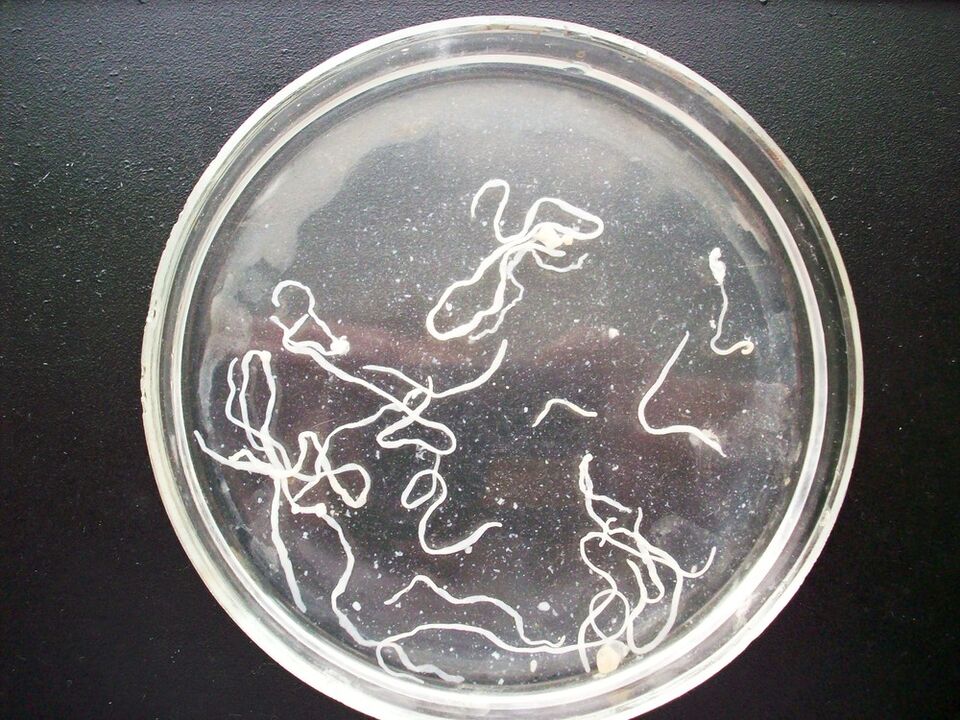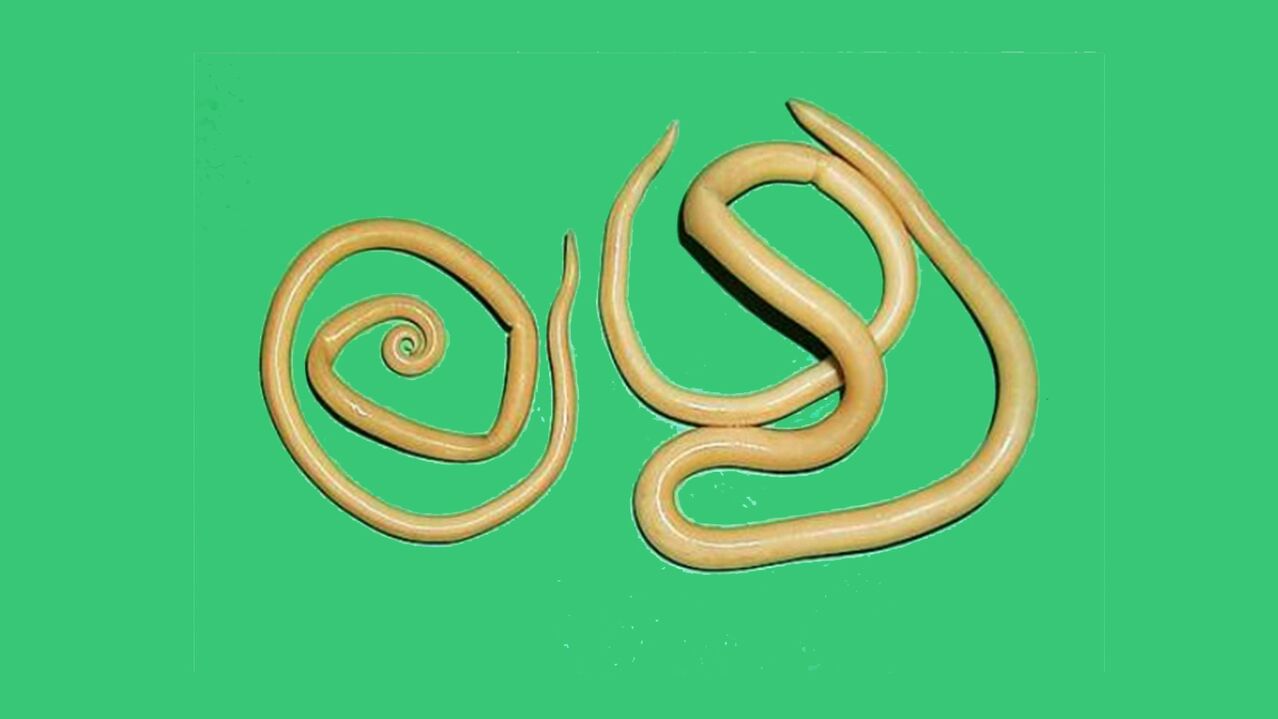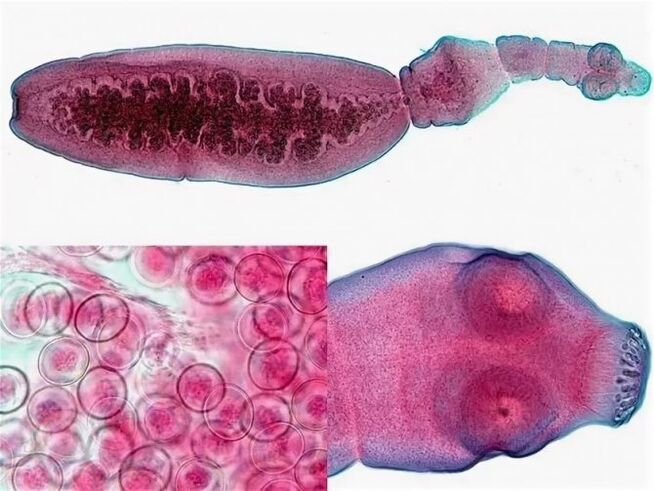
Pinwormis a frequent guest in children's groups. This is a medium-sized inhabitant (up to 1 cm long) of the small and large intestines, lays eggs, coming out of the rectum, in the folds of the skin, underwear and bedding. This happens most often at night, accompanied by severe itching in the anus. Moth eggs ripen after 4-6 hours and are ready to cause disease, they are perfectly preserved in the environment. They enter the human body with dust, with dirty hands, through soft toys, underpants, plates.
Make a diagnosis - scraping the skin around the anus and microscopic examination is required, at least 3 times at 3-day intervals.
When moth eggs are found, the entire family of infected people should be examined.
In the world, about 350 million people are infected with enterobiasis, when a family member is infected, the danger of the disease for all families is very high.
Toxocara - a parasite
Toxocarais a parasite in the digestive system of dogs. In the USA and Europe, 80% of dogs and more than 50% of adult dogs have toxocariasis. Research in humans has shown that up to 37% of the population is sensitized to the Toxocara antigen. This means that these people were or are now carriers of the toxocara.
The Toxocara is up to 30 cm long, in this form it lives on the body of its permanent owner - a dog. The dog releases toxocarbon eggs in the sand, soil, where they can persist for several years. With the sand, they fall into the hands of children who play in the sandboxes, and they also stick to shoes and clothes. Entering the person is a dead end for the parasite, as the larvae mature, spread through the vessels and internal organs, but do not stand out.
To make a diagnosis, stool analysis is not informative, a biopsy of Organs affected organs (usually the liver) and immunological tests are required.
The most tragic thing is the displacement of toxocar to the eyes (in 15% of cases of eye removal in the world due to toxocara), injuries to the lungs, heart, brain, muscles are also unpleasant - fever, cough, enlarged liver, inflammation of the lymph nodes, skin rashes, nervous and mental disorders, seizures.
Ascaris - a parasite

Ascaris- affects up to 100 million people annually. It strikes a person with food (usually herbs, vegetables and uncooked fruits), raw water, dirty hands, dust and is actively carried by flies. The worm length is up to 40 cm, a female worm secretes up to 200, 000 eggs daily, which enter the soil and are well preserved in it for years. The swallowed roundworm egg turns into a larva in the small intestine, penetrates the intestinal wall, enters the blood capillaries and is transported to the liver, brain, eyes, heart and lungs. In the process of movement, roundworms feed on blood - erythrocytes and nutrients. Anemia (anemia) is a frequent companion to ascariasis.
Migration of larvae causes allergies in humans, pain throughout the body, fever, increased risk of asthma, arthritis, neurodermatitis, eczema, seizures. If it enters the lungs due to the rupture of blood vessels, hemorrhages and hemoptysis are possible on radiographs - infiltrates, as in a tuberculous process.
Moving along the bronchi to the pharynx, roundworms with expectoration enter the mouth and, from there, the esophagus, stomach and intestines. In the intestine, roundworms are retained, resting against the walls of the intestine, causing inflammation, infiltration and hemorrhage. Complications are possible when the roundworm enters the sinuses, liver, bile ducts, pancreas and kidneys. There is intestinal obstruction, suppurative processes in the abdominal cavity. The diagnosis is based on stool analysis (at least 3 times), immunological tests - in the larval period.
Hookworm - a parasite
Hookworm- can enter a person through the skin when walking barefoot (leaves no trace), as well as, like the roundworm, through the mouth. Hookworm sizes - up to 1. 5 cm, migrate and damage in the same way as the roundworm. One feature is a symptom such as a rash on the skin with itchy limbs and more pronounced anemia.
Stool analysis, as in most invasions, should be performed at least 3 times.
Wide tape - parasite

The broad tapewormis a large long liver,the length of an individual is up to 10 meters, life expectancy in the human body is up to 25 years.Can you imagine what happens to a person if there are several such big centenarians in there?
Imagine how the worm is twisted in the intestine, how little space is left in the lumen of the human intestine! If the worm "straightened up", half its length would be out! In fact, the worm absorbs all the necessary and useful substances for you over the entire surface of the body.
You can become infected by eating raw, lightly salted fish, crayfish and caviar. Symptoms of the presence of a tapeworm can be anemia, tiredness, abdominal pain, especially signs such as increased salivation in the morning, vomiting, nausea, weakness, lethargy, drowsiness should be alerted. Intestinal obstruction is possible.
A completely stunning effect on an unprepared person is produced by the release of the severed parasite's "tail" from the intestines - this is a characteristic of the tapeworms that helps in the diagnosis.
Bovine and swine tapeworms are parasites
Bovine and swine tapeworms are parasites that enter the human body with raw meat, meat products and lard.
The length of an adult bovine tapeworm is up to 7 meters, that of a swine tapeworm up to 2 meters, life expectancy is up to 20 years, and the main danger lies in the migration of larvae, whichthey are capable of penetrating even the eyes and the brain.
Echinococcus and Alveococcus - parasites

Echinococcus and alveococcus are parasites that a person is infected by contact with animal carriers, drinking contaminated water, swallowing soil with fruits and vegetables.
The larvae of the intestine are transported through the bloodstream throughout the body, entering the liver, lungs, kidneys, bones and brain. The larva turns into a cyst, which grows by pushing and compressing the surrounding tissues. Symptoms depend on the location of the cyst and the degree of organ compression.
Cyst rupture is a very terrible complication.
Giardia - a parasite
Giardiais the simplest parasitic animal in the flagellate class. It is pear-shaped, 10–20 µm in length; the dorsal side is convex, the ventral side is concave and forms a suction cup for temporary fixation to the epithelial cells of the host intestine. 2 oval nuclei, 4 pairs of flagella. It lives in the human intestine (mainly in children), mainly in the duodenum, less often in the bile duct and gallbladder, causing giardiasis. Asymptomatic parasitic carriers are common. Infection with cysts occurs when protozoa enter the small intestine through the mouth when contaminated food or water enters the body, as well as through dirty hands, etc. The incidence is sporadic. Giardiasis is common in all parts of the world.



































